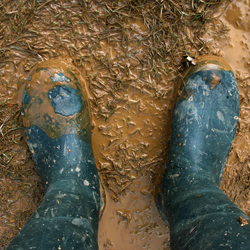More water is always good for plants, right? Wrong! When water stands in the soil, air is displaced, which in turn smothers the plant roots. Once the roots are damaged many symptoms appear on leaves and shoots including wilting, marginal and inter-veinal browning of leaves (scorch), poor color and stunted growth. But the excess water isn’t always coming from overwatering, it may be the result of poor draining soil.
Poor drainage is often produced in disturbed sites when heavy clay soil is compacted by construction machinery or other excessive use, such as yards where several children are often playing. Areas cultivated for plantings, such as flowerbed or borders, then collect water running off the compacted ground – this is called the teacup effect. Wet areas may also be the result of swales, drain spout runoff and low areas even when soil percolation is adequate in most of the site but when general moisture levels are routinely high.
To check for a potential drainage problem, dig a hole at least 2 feet deep, fill it with water and note how long the water remains. If it doesn’t drain completely away within 24 hours a severe drainage problem exists.
Fortunately, you can correct drainage problems in different ways. Easy options include…
- Divert water past plantings using drainage pipes, splash blocks or rain chains.
- Plant in mounds or raised beds so water will run off and away from the plants.
- Install drain tiles in saturated areas or use French drains to contain excess water.
- Amend the soil with organic matter such as compost to improve its structure.
An even easier solution is to simply select plants that tolerate wet sites. The following trees and shrubs tolerate wet sites and flooding better than most. Few tolerate standing water for long periods (those that grow in truly swampy conditions are marked *), but all will do better in wet areas.
Shade Trees
- *Acer rubrum/Red Maple
- *Betula nigra/River Birch
- Liquidambar styraciflua/Sweet Gum
- Alyssa sylvatica/Sour Gum
- Platanus occidentalis/Sycamore
- Quercus phellos/Willow Oak
- *Salix spp./Willow
- *Taxodium distichum/Bald Cypress
Flowering Trees
- Amelanchier Canadensis/Serviceberry
- Magnolia virginiana/Sweetbay Magnolia
Evergreen Trees
- Calocedrus decurrens/Incense Cedar
- Ilex opaca/American Holly
- Thuja occidentalis/Pyramidal Arborvitae
Deciduous Shrubs
- *Aronia arbutifolia/Chokeberry
- Clethra alnifolia/Summersweet
- *Cornus spp./Twig Dogwoods
- Enkianthus campanulatus/Enkianthus
- Ilex verticillata/Winterberry
- *ltea virginica/Virginia Sweetspire
- Lindera benzoin/Spicebush
- Myrica pennsylvanica/Bayberry
- *Rhododendron viscosum/Swamp Azalea
- *Salix spp./Pussy Willow
- Viburnum spp./Viburnums
Evergreen Shrubs
- *Andromeda polifolia/Bog Rosemary
- *Chamaecyparis thyoides/White Atlantic Cedar
- *llex glabra/Inkberry
- Kalmia atifolia/Mountain Laurel
- Leucothoe spp./Leucothoe
Perennials
- *Arundo donax/Giant Reed Grass
- Aster nova-angliae/Asters
- Astilbe spp./Astilbe
- Chelone/Turtlehead
- Cimicifuga racemose/Snakeroot
- Helenium autumnale/Helen’s Flower
- Hibiscus moscheutos/Hardy Hisbiscus
- *Iris kaempferi/Japanese Iris
- Iris siberica/Siberian Iris
- *Lobelia cardinalis/Cardinal Flower
- Lobelia syphilitca/Blue Lobelia
- Monarda didyma/Bee Balm
- Myosotis scorpiodes/Forget-me-nots
- Tiarella cordifolia/Foam Flower
- Trollius europaeus/Globe Flowers
- Viola spp./Violets
Ground Covers
- Gallium odoratum/Sweet Woodruff
- Gaultheria procumbers/Wintergreen
- Hosta spp./Hosta
- Mentha spp./Mint
- Parthenocissus quinquifolia/Virginia Creeper
Annuals
- Cleome hosslerana/Spider Flower
- Myosotis sylvatica/Forget-me-nots
- Torenia fournien/Wishbone Flower
- Viola wittrockiana/Pansies
Not sure which water-loving plants to choose? We’d be happy to help you evaluate your landscape moisture and other conditions to help you choose the very best plants for your yard!

